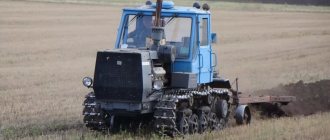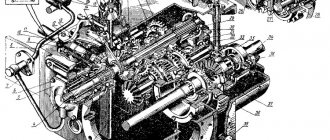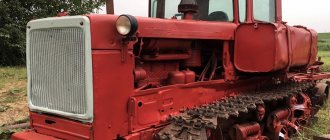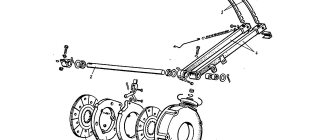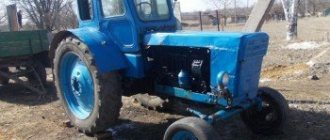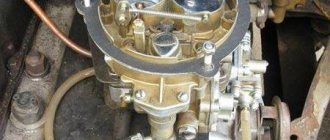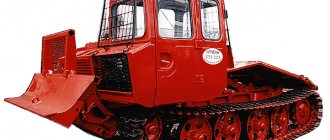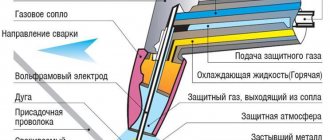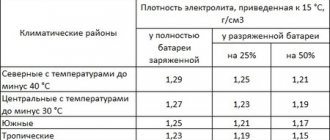Design of the MTZ-80 tractor
The MTZ agricultural machine in the 80th modification is distinguished by the high quality of its components and assembly. It is perfectly balanced, which makes the model stable both when driving on a straight road and when traveling off-road.
The Belarus MTZ-80 tractor is equipped with a reinforced bogie-type chassis. This unit is designed to combine high efficiency and simplicity of design. The rear axle of the chassis is equipped with a differential locking mechanism, which makes the agricultural machine more maneuverable. The front axle in the design of the unit is a driven one, and it does not have a differential lock. Spare parts for the chassis are made of reinforced silicon alloy with the addition of ceramic components. This makes them more resistant to heat, friction and corrosion. The photo will tell you in detail about the design features of the chassis.
To constantly monitor the operation of the chassis, the tractor is equipped with a clutch consisting of a power transmission shaft and a basket. A gear-type coupling regulates and maintains the operation of the mechanism when it is operated under variable and constantly high loads.
Depending on the configuration, the MTZ-80 agricultural machine can be wheeled or tracked. The MTZ-80 wheeled tractor shows higher speed and maneuverability. The unit, which is equipped with caterpillars, is more passable and stable on loose soil.
To make it possible to install different types of active and passive hitches on the tractor, its proprietary configuration includes separate-unit hydraulics, equipped with a built-in increase in adhesion mass and a power position regulator. The hydraulic system consists of 3 double-sided cylinders, a 4-link articulated linkage with a 3-point connection, and an oil pump that pumps up to 45 liters of fluid per minute.
The MTZ-80 unit is equipped with a reinforced braking system for maneuvering and stopping. It is complemented by a parking brake, which allows you to fix the agricultural machine motionless on a slope.
The MTZ-80 tractor includes proprietary electrical equipment that powers the electric starter, light and sound alarms, and built-in measuring instruments. High-quality electrical wiring provides a continuous voltage of 12V.
For more comfortable work on the site, the tractor is equipped with a soundproofed spacious glass cabin. It contains a soft driver's seat, built-in heating and ventilation systems, as well as controls represented by the steering wheel, gearshift lever and hitch control levers. The steering control and all the toggle switches necessary for operation are located in close proximity to the driver’s hands.
MTZ-80 tractor engine
The agricultural machine is equipped with a 4-stroke diesel engine of medium power, rotating at speeds up to 220 rpm. The engine consists of 4 cylinders with a diameter of 11 cm and a working volume of 4.75 liters. When starting an internal combustion engine, the cylinders are fired in the order 1-3-4-2.
The motor design includes a forged piston, the stroke range of which is 12.5 cm. To pump fuel, the engine is equipped with a 4-piston pump with preliminary pumping before starting.
An effective liquid-type cooling system is responsible for the continuous operation of the motor at high temperatures. It stabilizes the operation of the motor and automatically reduces speed when the maximum permissible operating temperatures are reached.
MTZ-80 tractor gearbox
As standard, the MTZ-80 model is equipped with a mechanical transmission. The built-in gearbox is equipped with a proprietary reduction gearbox, the gear ratio of which is 1.36. To effectively load a running engine, the manufacturer has provided the ability to switch tractor speeds in a range of 18 forward and 4 reverse gears.
The transmission mechanism of the agricultural machine includes a standard creeper, the operation of which is aimed at reducing the operating speed in order to save fuel consumption. The maximum speed of an unloaded tractor is 33.5 km/h.
Seasonal inspections
Maintenance of tractors largely depends on operating conditions, including climatic conditions.
In the autumn-winter period, pay attention to the following points:
- Ensuring that the cooling system is charged with refrigerant that is not subject to freezing.
- Operation of an autonomous heater and installation of insulating covers.
- Replacement of summer categories of oil with winter analogues, in accordance with the manufacturer’s recommendations.
- Deactivation of the radiator of the lubrication unit of a diesel engine.
- Setting the adjusting screw of the seasonal controller of the machine to the winter position (“Z”).
- The technology for maintaining tractors in winter involves adjusting the density of the electrolyte in the batteries to the appropriate standard.
- Check the working condition of devices aimed at facilitating starting of the starter.
- They check the tightness of the cooling unit, the integrity of the insulation, the supply of current from the generator, the heating of the workplace (cabin) and the effectiveness of the fuses.
Tractor MTZ-80 - technical characteristics
A well-thought-out design and the use of stable mechanisms allowed the manufacturer to increase the factory parameters of the MTZ-80 Belarus tractor.
The main characteristics of the unit include:
- traction class of agricultural machinery – 1.4;
- factory engine power – 80 hp. With.;
- torque at a rotation speed of 1400 rpm – 1290 Nm;
- fuel consumption per hour – 162 g/l. With.;
- torque reserve – 15%;
- fuel tank – 130 l;
- front/rear wheel track width – 1.35–1.85 m/1.8–2.1 m;
- ground clearance - 64.5 cm;
- the minimum radius for a full turn is 3.8 m;
- operating weight of the unit is 3.6 tons.
The dimensions of the tractor are relatively small. The length of the agricultural machine without hitch is 4.12, the width is 1.97, and the height of the unit along the steering wheel is 2.78 m.
Spring-summer period
Maintenance of the MTZ-82 tractor and similar machines at this time should also be carried out regularly. The list of work performed includes:
- Removal of insulating covers.
- Activation of the radiator operating system to lubricate the power unit.
- Disconnection of the autonomous heater of some components from the cooler.
- Installation of the relay-type adjusting screw in position “L” (summer).
- The density of the electrolyte composition in batteries is adjusted to the summer norm.
- Removing scale from the cooling unit, if necessary.
- Fill the fuel part with fuel whose characteristics correspond to summer grades.
Also, the organization of tractor maintenance at this time includes checking the cooling system for maximum cooling capacity of the radiator. This takes into account the presence of lubricant on the rubbing elements, as well as the integrity of the electrical wiring and its accompanying elements. Check the operating current of the regulatory relay. It is noteworthy that seasonal maintenance of the MTZ tractor can be excluded if it is operated in the southern climatic region.
Preparing the MTZ-80 tractor for work
To extend the service life of the starter, fuel system and CPG of the model engine, you need to properly prepare it for subsequent operation.
To do this you need:
- Thoroughly wash the tractor body;
- Inspect the metal for rust. If it appears, as soon as possible, the problematic parts of the body will need to be treated with a rust preventative, coated with a primer and painted;
- Remove the batteries and charge them;
- Remove the protective polyvinyl chloride covers;
- Install the previously disconnected cylinder block and radiator valves. After removal, they must be stored in a special protective box;
- Check the amount of oil in the engine crankcase, in the protective housing of the fuel pump, in the sump of the standard air cleaner, power transmission, gearbox, as well as in the hydraulic system reservoir and power steering housing. If necessary, the oil must be added or completely replaced;
- Lubricate the moving mechanisms of the tractor as indicated in the lubrication table;
- Fill the fuel tank with fresh fuel;
- Fill the cooling radiator with clean distilled water;
- Check the air pressure in the tires;
- Install charged batteries in their original places;
- Increase the track width of the tractor's front wheels to 1.4 m or more. The video will tell you clearly about the preparation of the MTZ-80 tractor.
During operation of an agricultural machine, it is necessary to carry out regular maintenance. The operator must monitor the condition of the operating mechanisms of the unit and, if necessary, carry out timely repairs.
Run-in
Maintenance of tractors during the operational run-in period involves a number of mandatory manipulations. Among them:
- Cleaning cars from dirt and dust.
- External inspection for leaks of fuel, lubricants and electrolyte, elimination of existing leaks.
- Monitoring the oil level and topping it up to the required level.
- Carrying out a similar procedure for coolant.
- Checking the operation and condition of the diesel unit, steering unit, windshield wipers, brake system, alarm and lighting elements.
- After three work shifts, the tension of the fan and generator drive belts is additionally carried out and adjusted.
Areas of operation of agricultural machinery
A fully serviceable MTZ-80 tractor can be operated with different types of mounted implements.
Their list includes:
- plow, harrow, cultivator, rototiller - the width of the equipment should not exceed 2 m, and the weight should not exceed 1 t;
- seeder, sprayer, rake, potato planter, potato digger with a weight of up to 0.8 tons;
- blade up to 1.5 m wide and weighing up to 1.3 tons;
- kun - its total weight together with cargo should not exceed 1.8 tons.
The MTZ-80 tractor can also be equipped with drills, branch choppers, mulchers and trailers, the total weight of which, including luggage, does not exceed 2 tons.
What does TO give?
The basis of maintenance is caring for the tractor. These manipulations make it possible to regularly check the performance parameters of the equipment. At the same time, much attention is paid to lubrication and tightening of fasteners, which directly affects the safety and duration of operation.
Correct and timely maintenance creates the prerequisites for stable, high-performance operation of machines and units based on them, the consumption of fuels and lubricants is reduced, downtime of tractors is reduced, and the cost of their repairs is reduced. If you follow the instructions of the factory instructions, which for the most part were approved back in the fifties of the last century, maintenance must be carried out every shift, monthly and after a certain number of working hours. In this case, the types and design features of the equipment are taken into account.
As a rule, the frequency of maintenance of machines and tractors in technical terms is taken into account after working out a specific number of arable or construction hours. The entire process is regulated by regulations and standards developed by advanced machine operators together with scientists. This is very important, since when developing a maintenance plan, it is worth taking into account many factors, including climatic conditions, fuel costs, engine type and other tactical and technical characteristics.
How to calculate engine hours?
By the way, on many expensive German foreign cars (for example Mercedes, BMW and others), there is a special counter that counts them. And then it just shows you that you need to go for an oil change, after which it resets to zero and you drive until the next maintenance. That is, there seems to be no exact interval here, AS I THINK THIS IS VERY CORRECT.
German cars often have turbines, the oil wears out even faster because it passes through some components of the turbocharger, removing heat from it and lubricating it, which is why the MOTOR HOURS will be reduced here! Even “top” synthetics are often recommended to be changed every 300 hours.
Method one
However, other modern cars do not have such counters! But there is a calculation of average speed. And here, using logic, you can display the interval.
It is very easy and simple to do, you can even create a small formula.
P=S*M (where P is mileage, S is the average speed of the car from the on-board computer, M is engine hours).
Ideally, after changing the oil, we need to reset the average speed counter and drive at least 2000 km; at low mileage this simply will not be relevant. Then you will have enough data to calculate everything.
ON my car it’s 29.5 km/h, I use a synthetic compound designed for 350 MPH. Thus, 350 * 29.5 = 10325 km. Here is the real replacement period, BUT NOT 15,000 km.
Of course, if your main job is outside the city and you travel intercity, then your average speed will be higher. For example, my friend has it at 50 km/h and also uses synthetics. So much for 300*50km/h = 15000km.
However, residents of large cities such as Moscow or St. Petersburg, where you can be stuck in traffic jams for several hours, this figure can be only 18 - 20 km/h, then 300 * 18 = 5400 km.
Method two
Another replacement option is based on fuel consumption. Ideally, in a combined cycle, my car will consume 8 liters per 100 km. If I calculate how much it will spend on 15,000 - 1,200 liters, that's when I should change the oil! 1200 – remember this number.
However, with winter warm-ups, the consumption in traffic jams is much higher, I have 10.6 liters. As a result, for 15,000, the consumption is 1590 liters, which is 390 liters more. If you derive the formula and calculate how much mileage is needed to reach 1200l, then it turns out to be approximately 11320km.
Again, far from 15,000 km!
In my opinion, changing according to engine hours is correct! And with the increase in the number of cars in cities, and, accordingly, traffic jams, we will come to this. IF MARKETONISTS ALLOW.
Now we are watching the video version of the article.
What oil is better to fill in the T-25 tractor
To process equipment of the T-25 model, you should use only the types of lubricants recommended by the manufacturer. Products offered by stores must meet technical standards.
The following brands are suitable for the engine and pump: M10V, Dp-11, Ds-8 (M8V). The additive IHP of the first series is allowed. The oil for the T-25 tractor model, according to the instructions, must be replaced every 240 operating hours.
Automotive grease of the AKP-10 and AK-15 brands is well suited as a lubricant for the hydraulic system, transmission mechanisms, hydraulic pump drive, and bearings. To prevent premature contamination of the technical solution, the following rules should be followed:
The oil used for the T-25 tractor must be clean, without impurities or added water.
Source
Parts lubrication
Oil is poured into the T-25 tractor not only into the engine; other equipment and elements of the machine are subject to regular treatment. Among them:
The fuel pump is primed at the same time as the engine. The liquid is introduced by injecting the solution with a syringe through the neck, which is located on top of the structure. The level is monitored using control marks on the side surface of the device. The liquid drains through a drain located at the bottom of the housing. Before replacement, the pump is flushed with diesel fuel by injection from a syringe, after which the drain cap is closed.
The air cleaner pan is filled with fresh fuel monthly. The interval may be shortened if the machine operates in conditions of increased air pollution. The tray along with the cassette must be washed before each procedure. The clutch is treated with grease in the flywheel area.
The bearing is lubricated immediately after dismantling the engine. To do this, remove the casing from the flywheel and clean the surface of the parts with diesel fuel.
Tractor oil is also used to lubricate the hydraulic pump drive. The process is performed by spraying liquid from a syringe. The required volume is monitored using the control cap. The oil is drained into the neck through the bottom of the container.
After how many engine hours should you change the engine oil? Must know
Now the average oil change interval is approximately 10 - 15,000 kilometers.
And in other European countries, this interval can often be increased UP TO 20 - 25,000! And you and I are all accustomed to changing exactly according to this framework, that is, after a certain mileage. BUT is this correct? And why do power units no longer last long on some modern cars? Let's say - they work out their warranty period and then give up. The main reason here lies in oil, mileage and traffic jams in big cities. Let's figure it out... Of course, if you are used to buying new cars, rolling back the 150,000 warranty (passing MOT after 15,000), and then handing over the car for a trade-in, then this material is not for you. Still, this article is for those who want their engine to work for a long time, sometimes even longer than the period stated by the manufacturer.
Procedure for replacing lubricant
The T 25 tractor has technical features, so the oil is changed in accordance with a scheme that includes lubrication of almost all equipment that ensures the operation of the machine.
Oil in the T25 modification tractor is poured into the hole in the engine crankcase, which is located to the left of the front of the engine. To determine the required amount of liquid, you need to focus on the marks on the measuring base. The first check is performed 15 minutes after the engine has stopped running, when the material has completely settled from the walls to the bottom of the container.
To replace the level, remove the measuring rod, wipe it and reinsert it until it stops. After this, the measuring element is removed again and the mark of the wet segment is inspected.
Tractor oil is drained immediately after stopping the engine, so that the impurities included in the composition do not settle into sediment. To do this, a drain hole is opened on the bottom wall of the container, and the liquid is drained into the bowl.
If the oil is hot, protect your hands with gloves. For the replacement procedure to be effective, it is important to thoroughly rinse the housing, rotor, and centrifuge hood, remove metal dust from the flange magnet, and rinse the receiver grid from contamination.
Brands and filling volume
The capacity of the units is not predetermining for refueling. A certain amount of oil or lubricant must be poured into the system. Before adding fluid or lubricating components, it is necessary to clarify which brand should be used.
When operating the tractor in the cold season at temperatures up to +5 C, it is necessary to use M-8DM engine oil, which complies with GOST 8581-78. You need to fill 12 liters. The same amount of lubricant, but the M-10DM oil grade according to GOST 8581-78 must be renewed at an ambient temperature of +5 C or more. The lubricant must be changed every 500 hours. You can also use alternative options: M-10G2K and M-10G2. The first sample is changed every 250 mph, and the second 500 mph.
One of the above oils can be filled into the fuel pump. The reason for replacing the fluid in the unit may be its repair. In other cases, it is not required to fill it. The fuel pump holds 0.25 liters of engine oil.
The air cleaner is another tractor component that requires engine oil. But there is a peculiarity here. You can add processing by letting it settle. Replacement is made every 500 hours. But be sure to know how many liters of oil to add. In this case - 1.5 liters.
The power transmission filling capacity is 40 liters. The system is fully charged. At each scheduled service, it is necessary to replace 40 liters of transmission oil TAp-15V, TSp-10 or TSp-15K. Can be duplicated by others - TAD-17.
The wheel gearbox holds 3.7 liters of the same oil as the transmission. Unlike other elements, the gearbox must be filled at two points at once. The wheel reducer, upper bevel pair, drive support and drive pulley are filled with Tap-15V and other similar oils.
All hydraulic units and HPS are filled with modernized M-10G2 engine oil. You can use others: M-8G2K or M-10G2K. The same applies to the power steering; the same oil is used there.
The lining bearing is lubricated with Litol-24. As an alternative, LCP-GM multi-purpose grease can be used. This must be done both during operation and maintenance. To fill 0.2 liters of working volume, you must use a special syringe. A few injections will be enough.
Litol-24 can be called a universal lubricant. It is used in the hub bearing in an amount of 0.4 l, steering knuckle, brace gear, bushings, hinges, bearings in various quantities.
When adding used diesel oil to the pump, it must be taken into account that in winter, when the temperature drops below -20 degrees, it can freeze, so it is important to use AU spindle lubricant. At a temperature of -55, dilution with diesel fuel by 15% is relevant.
Marketing component
For new cars, the oil change is dictated to us by the manufacturer, and this process miraculously coincides with the next maintenance. That is, we are somehow getting used to giving a lot of money when we come to the dealer in 15,000, they will tweak something for us and look at something, so here you are 6,000 - 10,000 rubles! EXPENSIVE, yes of course EXPENSIVE! Therefore, now drivers look at the service interval and the longer it is, it is considered better.
BUT IS THIS CORRECT? Of course not. Moreover, now many car owners live in big cities with a lot of traffic jams and threshing engines in them; it is also worth adding auto starts in the morning or set on a timer (turned on by time or by ambient temperature).
And here you need to understand that the replacement should take place not according to mileage, but according to engine hours! And believe me, this greatly reduces the replacement interval in kilometers, by about half (but more on that a little later).
